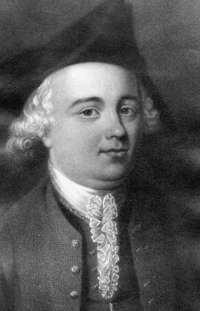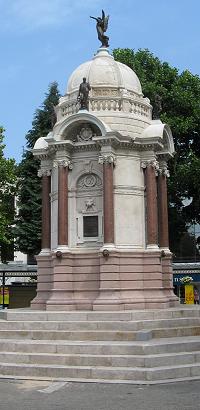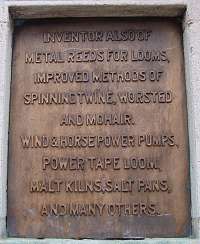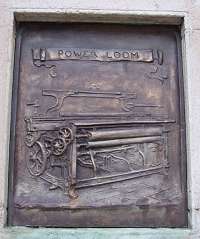This site celebrates the life and work of sculptor
John Cassidy (1860 - 1939).
John Kay. (Image provided by BwD for use in the Cotton Town digitisation project)
The Kay Memorial.
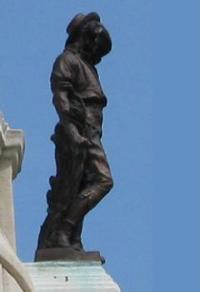
Above: 'Agriculture'
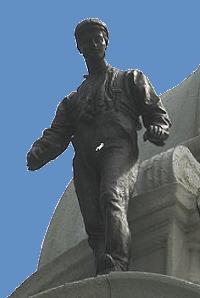
'Weaving'
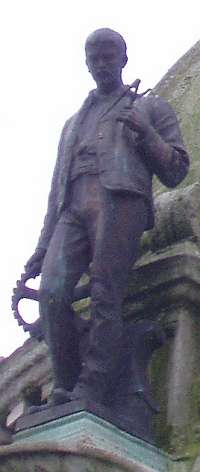
'Engineering' seen in 2008.
INVENTOR ALSO OF
METAL REEDS FOR LOOMS, IMPROVED METHODS OF SPINNING TWINE, WORSTED AND MOHAIR,
WIND & HORSEPOWER PUMPS,
POWER TAPE LOOM,
MALT KILNS, SALT PANS,
AND MANY OTHERS.
METAL REEDS FOR LOOMS, IMPROVED METHODS OF SPINNING TWINE, WORSTED AND MOHAIR,
WIND & HORSEPOWER PUMPS,
POWER TAPE LOOM,
MALT KILNS, SALT PANS,
AND MANY OTHERS.
The Whiteheads
Contribution by Hugh BarwellRobert Whitehead was born in Bolton in 1752, the son of the Vicar of Westhaughton. In 1771 he moved to Bury and opened a steam-powered cotton bleaching works at Lower Croft in Elton, now part of Bury. His business prospered and he purchased Haslem Hey, a large property also in Elton. Other accounts say that his family had been bleachers at Lower Croft for much longer, and that many generations of Whiteheads lived at the old house, Haslem Hey (sometimes spelled Haslam Hey).
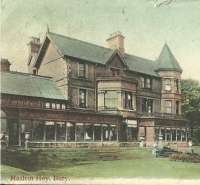
The old house was replaced by a Victorian mansion (above) in the 1870s, now also demolished.
His wife, Alice née Lever, bore him two sons, James in 1788 and John in 1790.
James Whitehead grew up to be a 'practical industrialist' and ran the family firm. In 1813 he married Ellen Swift.
James and Ellen's son Robert Whitehead, born in 1823, became an engineer, and is considered the inventor of the sea-borne weapon known as the torpedo, which he first developed in 1866. His work brought him fame around Europe. His granddaughter, Marguerite Hoyos, married Herbert von Bismarck, son of the German Chancellor, and another, Agathe Whitehead, married Captain von Trapp of Sound Of Music' fame.
John Whitehead, born in 1790, second son of Robert and Alice, lived at Haslem Hey, with his wife Elizabeth née Oram, a great-grand daughter of John Kay. He managed the family firm, and produced 6 children, and the 1871 census records him, aged 81, living in retirement in Elton. His eldest son, John, born 1815, produced 10 children with his wife Eliza née Allanson. Of these, the first, Edmund, died aged 20, the second became the distinguished surgeon Walter Whitehead, and the third, Henry Whitehead, ran the family bleaching company, and became a well connected industrialist and benefactor to Bury.
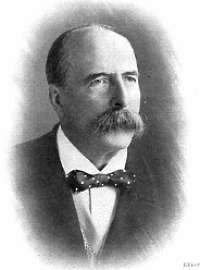
In more detail, Walter (pictured above), born in 1840, was educated for a time at a boarding school in the Isle of Man, and worked for three years in the family firm, but then enrolled at a Medical School (without telling his parents) and later became a Professor at Owens College and 'one of the most distinguished and brilliant surgeons of his day' according to Manchester medical historian William Brockbank. He retired in 1903 to Colwyn Bay in North Wales, where he died in 1913. His 37-acre estate above the town is now home to the Welsh Mountain Zoo.
Bury's Clock Tower, designed by Maxwell and Tuke 'In eclectic, mainly neo-mediaeval style', was given to the town by Henry Whitehead in commemoration of his elder brother Walter.
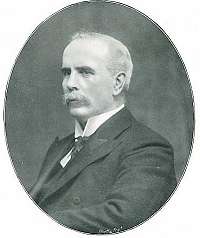
The bleaching firm passed, along with the house at Haslam Hey, to Henry Whitehead, (picture above, from Contemporary Biographies) born in 1842, Bury's great benefactor, who paid for the John Kay memorial. Henry served as High Sheriff of Lancashire in 1903, became a Deputy Lieutenant for Lancashire, and Justice of the Peace, as well as Managing Director of the Bleachers' Association. He held directorships of the Lancashire and Yorkshire Banking Company Ltd, and of Messrs. Armstrong and Whitworth of Newcastle upon Tyne. He was later knighted.
Whitehead Park, Elton was established in 1883 with contributions from Lord Derby, the Lord of the Manor, a public subscription and generous contributions of money from Sir Henry. Among Henry's other benefactions are the clock and chimes in the tower of St Mary's Church, given in 1903, and paintings in Bury Art Gallery.
Henry and Walter were directly descended from John Kay. Their great-grandmother Lucy Kay was a grand-daughter of John Kay, according to A Memoir of John Kay by John Lord, published in 1903:
'It is interesting to recall the fact that Henry Whitehead is a direct descendant of that great but hitherto sadly neglected genius. His grandfather, the elder John Whitehead, married Miss Elizabeth Oram, daughter of Mr.Thomas Oram by his wife Lucy, who was a daughter of Robert Kay the inventor of the Drop-Box, and a grand-daughter of John Kay the inventor of the Fly-Shuttle. This descent is naturally much cherished by the present generation of Whiteheads.
'Dr. Walter Whitehead referred to it with pardonable pride in his Presidential Address to the members of the British Medical Association on July 29th last and Mr. Henry Whitehead recalled it when on a recent occasion he presented the Bury Art Gallery Committee with a portrait in oils of John Kay.'

Special thanks to Hugh Barwell, a descendant of the Whitehead family, for his comments and corrections to to the Kay family story.
The John Kay memorial, Bury, Greater Manchester
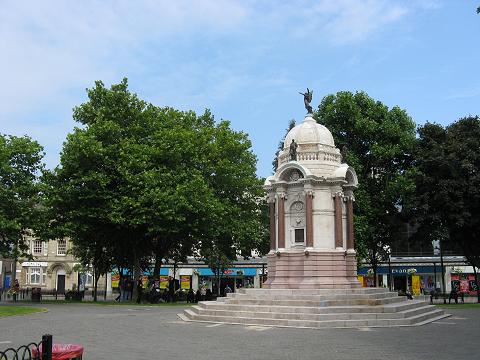
We are pleased to report that the Kay memorial has been cleaned and refurbished in 2011, an operation which was very badly needed: we have updated this page with new pictures to celebrate the occasion.
Arrive in Bury by bus or tram, visit the town's famous market or shopping centre, and you cannot fail to see the Kay Memorial, which is right in the centre of things, in the centre of Kay Gardens, an open space created from the former market place when a new market hall was built in 1901. The new space, and the memorial at its centre, erected in 1908, were paid for by Henry Whitehead, a wealthy local millowner (see lower left column).
An imposing (over ten metres high) and complex structure, designed by Bristol-based architect, William Venn Gough (1842-1918), the memorial, constructed by local builders, Thompson and Brierley, comprises, in the words of the Public Monument and Sculpture Association National Recording Project (PMSA):
Ornate Italianate domed
octagon on base of seven steps. Horizontally rusticated
based sandstone, re-used from the old market hall. Main
stage of eight red granite ionic columns broken forward
under entablature. These frame four bronze panels
depicting looms, the inscriptions and a medallion of
Kay.The dome of Portland stone is encircled by a
balustrade, surmounted by bronze figure of Fame, and
surrounded by smaller figures of Agriculture, Engineering,
Mining and Weaving.
The bronze statues, medallion and plaques are all by John Cassidy. Fame, perched at the top of the dome, is shown blowing a long this trumpet and holding a laurel wreath. Of the four workers the original description was: 'Agriculture' is a young man with a sickle, mopping his brow; Engineering is a man with a cogwheel and a pair of compasses or dividers; Mining is a bare-chested man with a pickaxe and safety lamp; and Weaving is the main in a cap holding a shuttle.' Our pictures show that the pickaxe, the safety lamp and the sickle are all missing: they would have been separate parts from the main castings, and may well have been stolen, or possibly removed in case they fell on the people who congregate around the memorial. Sadly, perhaps, they have not been replicated during the refurbishment.
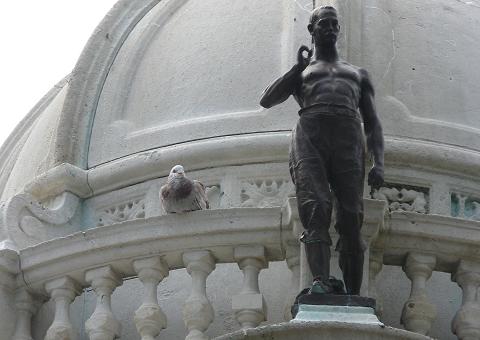
Above 'Mining.' A bronze copy of this statue was retained by Cassidy and appears as 'The Miner' in his 'Catalogue of a Small Collection' of 1914. The picture reproduced there shows how this one would have looked originally. 'Agriculture' is perobably also the same figure as listed in that catalogue as 'The Reaper.'
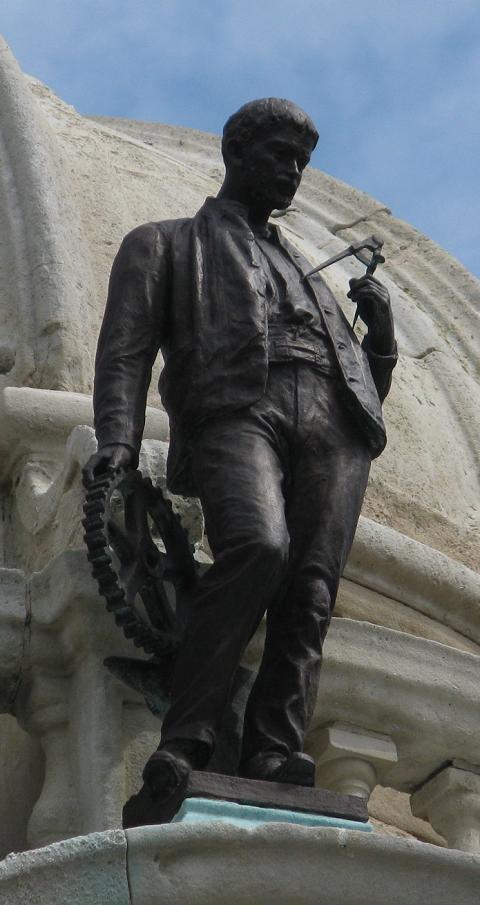
'Engineering' (above) has emerged particularly well from cleaning: he still has his original gearwheel and dividers.
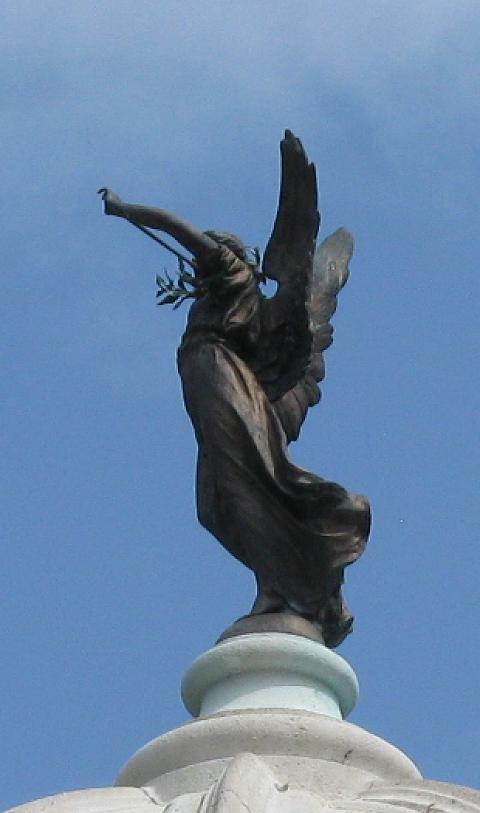
'Fame' has the look of a cousin of 'victory' seen on Cassidy's later war memorial work.
Kay Gardens and the Kay Monument were opened in April 1908. Mrs Henry Whitehead opened the gardens and the Earl of Derby unveiled the monument.
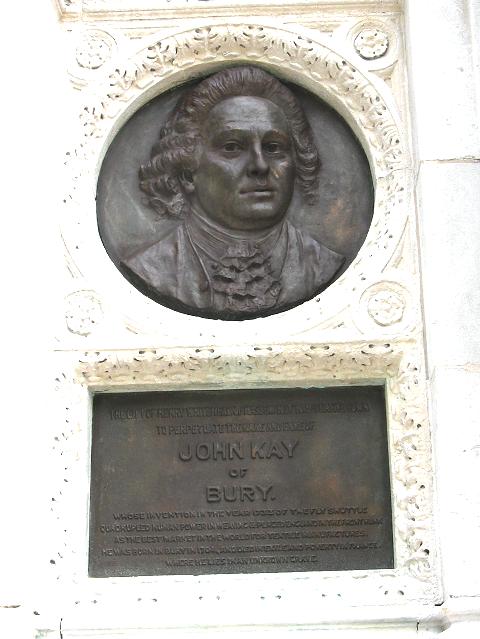
THE GIFT OF HENRY
WHITEHEAD OF HASLAM HEY TO HIS NATIVE TOWN
TO PERPETUATE THE NAME AND FAME OF
JOHN KAY
OF
BURY.
WHOSE INVENTION IN THE YEAR 1733 OF THE FLY SHUTTLE
QUADRUPLED HUMAN POWER IN WEAVING & PLACED ENGLAND IN THE FRONT RANK
AS THE BEST MARKET IN THE WORLD FOR TEXTILE MANUFACTURES.
HE WAS BORN IN BURY IN 1704, AND DIED IN EXILE AND POVERTY IN FRANCE,
WHERE HE LIES IN AN UNKNOWN GRAVE.
TO PERPETUATE THE NAME AND FAME OF
JOHN KAY
OF
BURY.
WHOSE INVENTION IN THE YEAR 1733 OF THE FLY SHUTTLE
QUADRUPLED HUMAN POWER IN WEAVING & PLACED ENGLAND IN THE FRONT RANK
AS THE BEST MARKET IN THE WORLD FOR TEXTILE MANUFACTURES.
HE WAS BORN IN BURY IN 1704, AND DIED IN EXILE AND POVERTY IN FRANCE,
WHERE HE LIES IN AN UNKNOWN GRAVE.
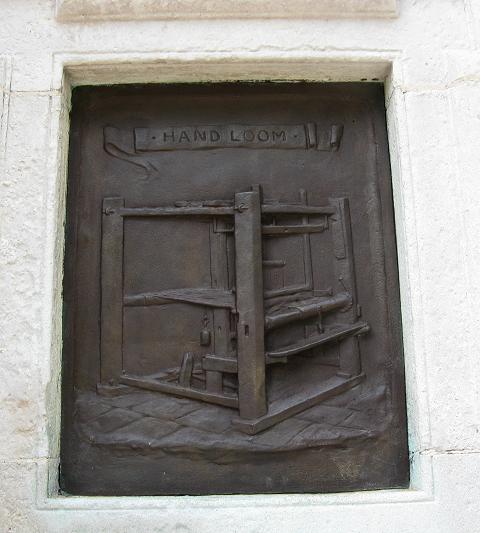
The memorial became sadly neglected, in parallel with the decline of the Lancashire textile industry, and by 1996 it was in such dangerous condition that it had to be fenced off. However, it was restored, although the condition of the dome by 2008 appeared to belie this fact. Originally there were railings round the top step of the plinth - perhaps these vanished in the Second World War scrap drive. In 2011 the whole monument was clearned and refurbished again.
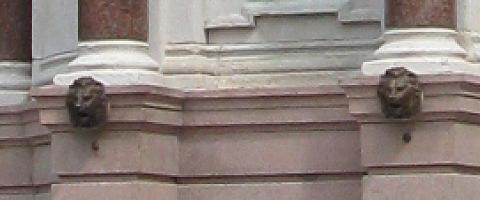
These lions' heads are presumably also by Cassidy.
John Kay (1704–1780/81), was born at Park Farm in the parish of Bury, Lancashire, on 16 July 1704, the fifth son of prosperous farmer Robert Kay (1651–1704) and his wife, Ellen, née Entwistle, of Quarlton.
He is famous in Lancashire the 'Inventor of the flying shuttle' - the flying shuttle being a mechanism for speeding up the production of cloth on a hand-operated loom. He was in fact a prolific inventor; his first invention, which passed into general use, arose from he first employment as a maker of reeds, and was an improved reed for the loom, which substituted thin wire for the usual strips of cane or reed. In 1733 he patented a shuttle, which was much lighter than the existing one, ran upon four wheels, and could be used for weaving woollen or linen broad-goods. Termed at first a wheel-shuttle, a spring-shuttle, or a bobbin-shuttle, it was only later called a fly-shuttle. Unfortunately Kay's business skills did not match his ingenuity, and he charged so much for the use of his invention that it was widely pirated. Other ideas were a water-powered device for raising water from mines, and a new type of loom for weaving tape.
In 1747 he emigrated to France, where he set up as a manufacturer of his designs, with encouragement from the French government. Historian Douglas Farnie wrote:
To help him in the task of
manufacture in a Paris workshop he brought over three of
his sons from England - Robert Kay (1728–1802), James Kay,
and John Kay (1740–1791) - but he soon found that French
weavers were diligently counterfeiting ‘the English
shuttle’ (la navette
anglaise, as it was styled in a French
publication of 1763).
Unfortunately his inventions were pirated in France too, but by all accounts he made a reasonable living. He died in the south of France during the winter of 1780–81. The exact date and place remain unknown, as does the site of his grave; at the time France and England were at war.
Although he left Bury, he has always been seen as a celebrated son of the town and one of the men responsible for Lancashire's success in the cotton industry, although he left before the development of the cotton industry and powered looms. Legends have developed around him, including the idea that he was driven out of Bury by hostile weavers who believed his inventions threated their livelihoods, and 'died in exile and poverty' as the working on the memorial has it. The legend is fostered by being included in Ford Madox Brown's series of murals in Manchester Town Hall chronicling Manchester's history.
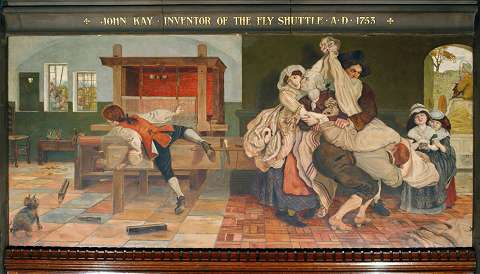
The official description of this work (above) from the Manchester City Council website reads: 'For thousands of years, weaving was done by hand, throwing the shuttle across the loom. If a wider cloth was needed, two weavers threw the shuttle to each other. John Kay invented a shuttle fired by a cord into boxes either side of the loom. On the left, rioters are breaking in to smash the loom, while Kay is being smuggled to safety.'
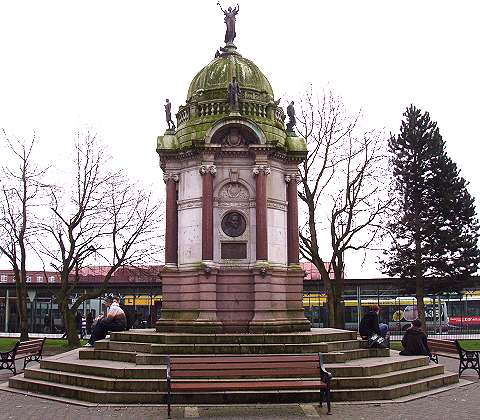
The memorial in 2008, before cleaning.
Links and References
Douglas Farnie: 'John Kay' - entry in the Oxford Dictionary of National Biography.
William Brockbank: The Honorary Medical Staff of the Manchester Royal Infirmary 1830-1948. Manchester University Press, 1965. (Available on Google Books)
Tracy, W. Burnett and Pike, W.T: Manchester and Salford at the Close of the 19th Century: Contemporary Biographies. Brighton: W.T. Pike & Co., 1899. (Available on the Spinning the Web website)
Robert Whitehead (1823 - 1905) - Wykenet
''[Walter] Whitehead's operations': British Journal of Surgery, Volume 12, Issue 48 p. 625-629.
The Kays of Bury district, Lancashire: a Rootsweb genealogy compiled by Stephen Painter.
Robert Whitehead: a brief history
The Cottontown Project: Blackburn with Darwen Council

